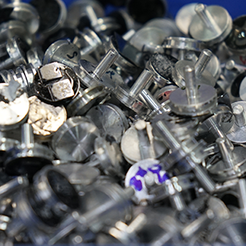
Sample Preparation for Electron Microscopy

More than for most characterization methods, electron microscopy makes great demands on the sample preparation. Accordingly, the preparation is of significant importance to ensure highest quality of electron microscopy measurements.
Most demanding is the preparation of samples for transmission electron microscopy (TEM), because the samples have to be extremely thin, that means electron transparent. Usually, the sample thickness should not exceed 200 nm. However, the thinner the sample, the better the quality of the TEM measurement. At the MPI-P we provide several techniques for the preparation of extremely thin samples for TEM like ultramicrotomy for soft matter bulk specimens, focused ion beam (FIB) for very demanding bulk samples, thin film drop casting and surface replication techniques, just to name a few. In addition to the extremely thin sample requirement, soft matter materials often suffer from a low contrast, which, in addition, has to be increased by means of further preparation steps like heavy metal staining or negative staining. The demands of every specimen are amifold and need individual strategies to achieve the optimum result.
This applies to some extend to the sample preparation for scanning electron microscopy (SEM) as well. Since SEM is a surface sensitive imaging method, electron transparency of the specimen is not an issue, main attention has to be payed to the contrast and – very important - to the electrical conductivity of the specimen.
The EM-group at the MPI-P operates different preparation lines to dedicated to the EM examination of soft matter and biological samples.
